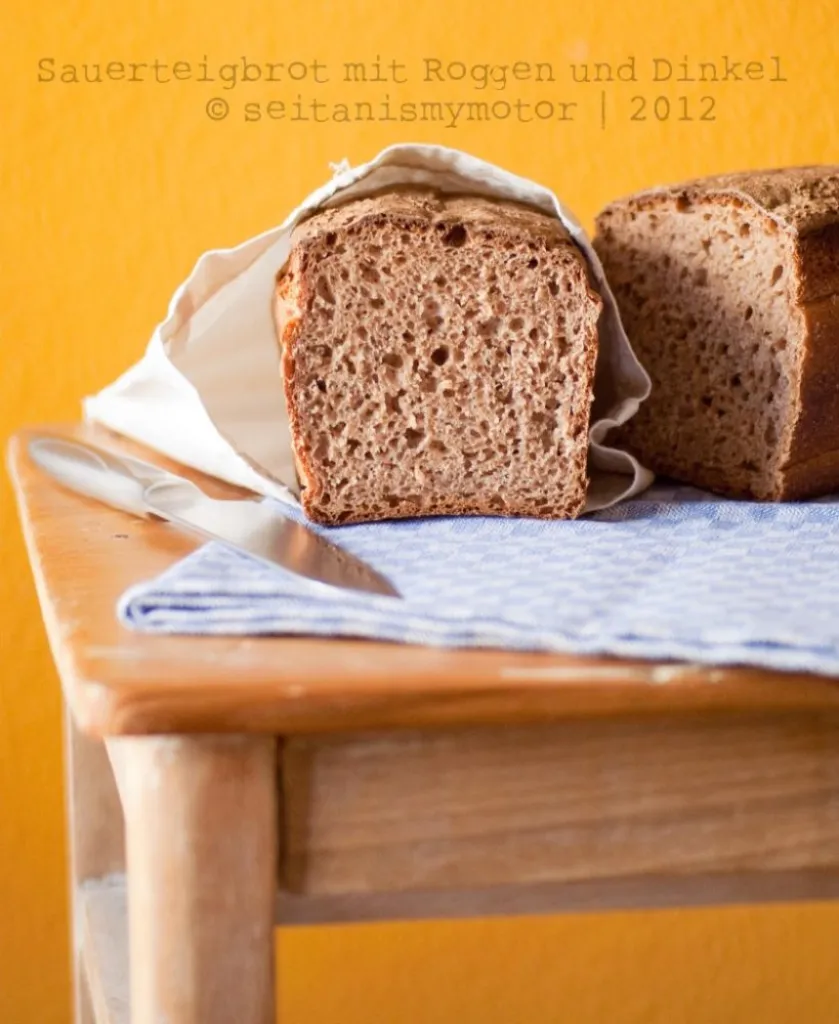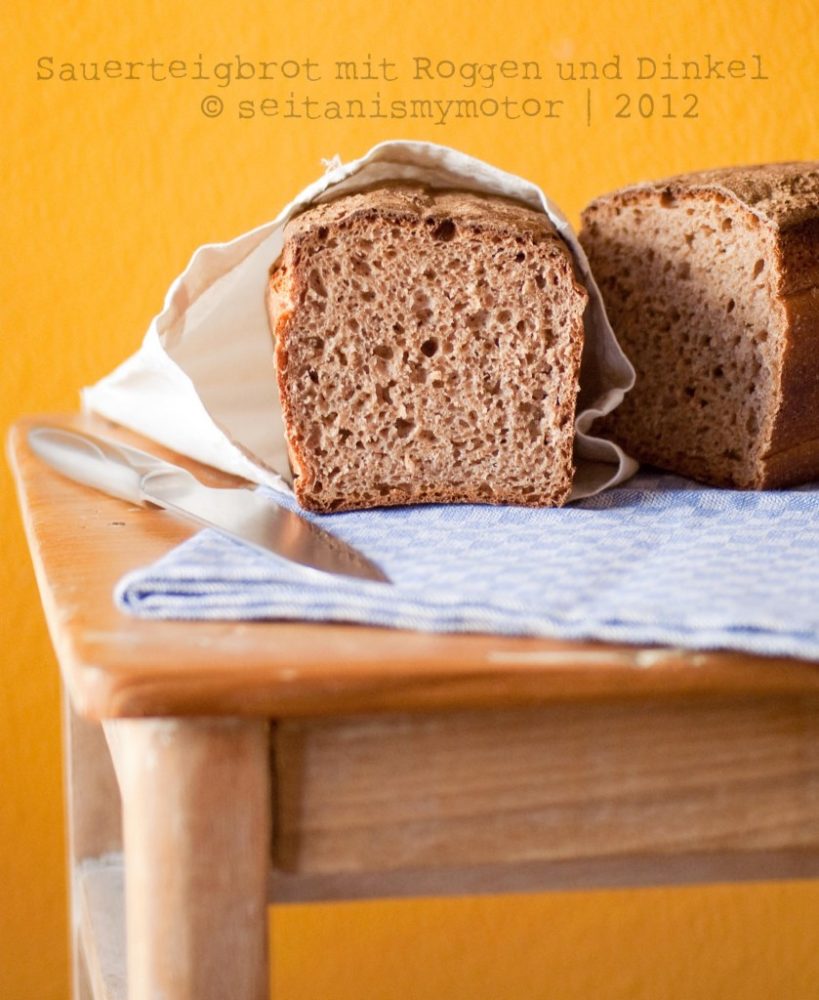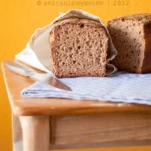This rye and spelt bread is an easy beginner sourdough loaf. If you don’t have a sourdough starter, it’s very easy to make one. All you need is flour, water and a little patience. Get started here with your own rye sourdough starter.

If you have never baked your own bread and the words „yeast“ and sourdough“ might scare you. At least I’ve been there. My first loaves were barely edible. I over-proofed them, used way too much yeast or dead starters, I baked my bread into bricks. For some people bread baking is an easy task from the start. But for others it takes some time to get the hang of it.
It takes a while to find out how long to knead the dough until the gluten is properly developed, to tell „proofed“ from „overproofed“ and when exactly to take the bread out of the oven can be another miracle. But believe me, you will get there. Just be a little patient.
Sourdough bread is my favourite because to me it tastes better than homemade yeast bread. And it keeps fresh much longer. Another benefit is that leavened bread helps to absorb some nutrients better than unleavened bread. Plus, if you use whole rye flour working with yeast just won’t cut it.
Some notes about this Sourdough Rye and Spelt Bread:
- This bread calls for 50% whole rye flour. Rye flour acts very differently from wheat flour when it comes to baking. The gluten will never develop much and the dough will be rather sticky. Don’t worry about that, your bread will still come out fine. The recipe also calls for whole spelt flour. Spelt flour is a flour diva, if you ask me. Some people need a lot of water for their spelt baked goods. Otherwise their loaves will come out very dry. Others don’t need that much water. This bread calls for a very large amount of water not only because I am using spelt flour, but also because it will improve the crumb and moisture of this loaf.
- The consistency of the dough will be more like a very thick cake batter.
- If you bake bread, you can never really predict what adjustments to expects. The flour quality (e.g. its starch and protein content, its ability to absorb water ) can be very different even from bag to bag. (And from country to country. Read more about this topic on my article on German flours.) But in this case it shouldn’t be much of a problem unless your dough turns out like a muffin batter. (I know this is probably not very helpful.)

Wholesome Rye and Spelt Bread
Zutaten
Starter
- 250 g whole rye flour (2 cups)
- 1 tbsp active sourdough starter
- 300 ml water (1 1/4 cups)
Bread dough
- 250 g whole spelt flour (2 cups)
- 10 g salt
- 1½ tsp caraway seeds (or to taste)
- 100 ml water (6 tbsp)
Anleitungen
- The day before, in a bowl, stir together ingredients for the starter. This is called refreshing the starter.
- Cover your bowl with a plate or plastic wrap and let sit at room temperature for 12-16 hours. (The dough likes it warm. Temperature should be above 20°C) Your dough should look bubbly and have doubled in size. It should also smell sour.
- The next day add remaining ingredients for the bread dough.
- Knead the dough for one minute. It will be rather sticky (especially because of the rye flour) and rather soft. Cover and let rest for 10 minutes. This will help to absorb the water properly and develop the gluten. Knead again for one minute. You will probably note that the consistency has changed and that the dough feels a little bit firmer. But it still will be rather soft.
- Line a loaf pan with parchment paper. (Sourdough can be a little hard on your pans. That’s why you shouldn’t grease the pan but use some parchment instead.) Transfer the dough to the pan. Use wet hands and slightly press to shape it a bit. Cover with a damp kitchen towel. Preheat the oven to 220°C (425°F). Let the dough rise until doubled in size. This will take 1-2 hours depending of your starter, the room temperature, etc.
- Bake for ten minutes. Lower the temperature to 200°C (400°F). Bake for 30 more minutes or until a toothpick inserted comes out clean. (Even better if have a meat thermometer – it will finally be useful – you can insert into the loaf. The temperature should be 93°C (200°F).
- Let the loaf cool completely before slicing. You can also wait a whole day to cut this bread, this will improve the flavour.

28 comments
Hello,
I have made this recipe twice and it tastes great. The dough rises to the edge of the loaf pan but then in the oven it doesn’t rise any higher. Is this normal or should I be expecting some oven spring?
Hi. Can I let the whole rye flour mix with starter sit in the fridge instead of room temperature? My room temperature here is between 30-32°C, does it too warm to sit in the room?
Hey Grace,
sorry for the late reply. I hope this is still relevant.
I would not recommend to let the dough sit in the fridge. If your room temperature is around 30°C that is actually great for a sourdough! I would recommend to keep an eye on it though and shorten the raising time. It probably won’t need 12-16 hours. Maybe check after 8.
This is an excellent recipe! I made this today and the bread turned out beautifully, and the directions were perfect. Thank you so much for including Imperial measurements, too!
Hi Elisabeth, this is awesome. Thank you so much!
Thank you! I just baked my first loaf ever using this! Came our delicious :) Just had one problem. I’m not sure what German parchment paper is, but I interpreted it as American wax paper. The paper baked right into the side and bottom of the loaf! Easy enough to cut off though.
That is great to hear, Steve! Sorry your paper got baked in. German parchment paper is the same as every other parchment paper and it is definitely not the same as wax paper. You should never bake with wax paper:) I am sorry about the confusion.
Thanks for the recipe! Not sure if you check this often since it is an old post, but do you think adding oats and seeds would work in this recipe? I plan on trying it, just wanted to see if you had any thoughts on changes that may be required for these additions.
Thanks again!
Hi Amanda, yes it would work! Substitute some of the flour (by weight) with your oats.
Hi! Firstly, thank you for this recipe and instructions on how to make a starter. I am new to baking but have decided to give it a go as I am wheat (maybe gluten?) intolerant. I thought I’d try a sourdough non-wheat bread before thinking about giving up gluten altogether. Anyway! I’d like to ask a couple of questions if I may? I just don’t want to do anything wrong! Firstly, in your starter article you say to keep 1 and a half cups of starter for the first bread, but in the rye/spelt recipe you say to only use 1 tablespoon. How much should I use? As I have a lot of starter (from five days‘ feeding), less what I keep in the fridge, should I discard the rest, or could I maybe freeze it to use another time? Thank you in advance! :)
Hi Gina, sorry for getting back so late. The bread recipe that comes with my starter is a recipe for a brand new starter. Often these starters just don’t have that much yeast yet. They just don’t work that well yet. (Usually – sometimes they do.) Therefore you can use a lot more starter. That recipe is only for a brand new starter and it’s also a way to actually use all that excess starter that builds up in the process of making it and that you’d usually discard.
A regular sourdough bread is made by refreshing a regular mother starter. If your starter works the way it should and is strong enough, a tablespoon taken from your mother starter is enough to make a fresh batch of starter for your recipe. If you want to make this recipe with a brand new starter and it won’t rise, you can also add a teaspoon of instant yeast to the bread dough to get it to rise properly.
I’ve never frozen a starter, but you can definitely dry it for later use. Spread a very thin layer on a piece of parchment and let it dry. Then pulverize it and store it in an airtight container. To use it, you just have to mix it with water and flour. That mixture has to sit for a couple of hours and then get back to life. Works like a regular starter.
In German we have all kinds of terms for this. In English I sometimes lack the words but I hope I could make this clear? If not, please don’t hesitate to ask again.
Please could I ask about the amount of starter to use? When you say tablespoon do I get my measuring spoons and measure a flat tablespoon of it, or do I just get a spoon I’d eat dessert with and get a spoonful of my starter with it? I’m wondering as I did the first one which would be less of the starter and it’s nearly 12 hours in a warm room and it hasn’t grown or bubbled at all. Thanks.
I use a spoon I would eat soup with. it doesn’t have to be super accurate. The most important part is that you have a well working, active starter. If nothing happened after 12 hours, the starter you used wasn’t strong enough. How do you usually refresh your starter?
Thanks for quick reply. I probably didn’t use as much as you do then. I refreshed my started 24 hours before using by throwing away half and replacing with 40g rye flour 40ml water, and when I came to use it there were quite a few bubbles going on.
Did your refreshed starter rise, too? If not it probably wasn’t strong enough. If you want to make this bread, you don’t have to follow my tablespoon refreshing method. You can also refresh as you usually do, just make sure that you have the same amounts of ingredients (250g flour, 300 ml water).
Hi, I want to make a 30% rye, 70% white spelt sourdough loaf. What adjustments to water and kneading method would you recommend?
Thank you!
That depends a lot on the properties of your flour but I would guess that you might need less water. I’d start out with 300-350 ml water and then adjust the measurements.
I love to make sour dough breads , but sometims it is difficult, because I have to change things, since I live in Florida, but your breads look delicious. How do you make the sour starter? please help and I could start with your healthy bread. thanks, Kerstin
I have a recipe on the blog and linked to it in this post. (Where it says „get started here“.)
I tried making this but think my starter was bad. My loaf is okay, but very short and dense. Boo
Sorry to hear that Kristen! Hope you have better luck if you decide to make this again.
Hi Mihl, your new format looks beautiful! Many of us fall off the bread wagon I suppose. I love baking bread, but then I eat it all! I do make my own pizza dough, which is fun. Hope you’re well!
Your bread looks delicious Mihl! I feel like I’ve been on a bread baking hiatus as well, it’s been ages since I’ve made any.
I’m so going to make this bread! I’m a huge fan of sourdough and just revived my starter. What a gorgeous loaf.
Mihl – you always make such beautiful bread.
Homemade sourdough is one thing I miss since going gluten-free. As for your bread-baking skills, you may have lost the starter and some of the energy, but clearly the skills are still intact!
I love sourdough bread, too. Your rye and spelt loaf looks fantastic!
The Bread Basket — just seeing those words made me smile, because I love your bread recipes! I’ll be making this bread pronto — well, as soon as I get a rye sourdough starter going. I haven’t had a starter hibernating in my fridge since I found out about my wheat allergy, and it never occurred to me to make one with rye.
Comments are closed.